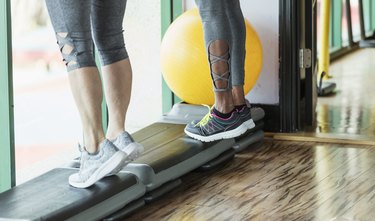
Sciatica can make it hard to sit, stand or walk. Symptoms of sciatica can be a literal "pain in the butt." As you age, your spine can begin to degenerate and sciatica is most prevalent in older adults due to its causes. Sciatica stretches for older adults can help.
Due to its size and position, the sciatic nerve is vulnerable to injury. The sciatic nerve branches off from the lumbar and sacral spine and runs through the pelvis and down the back of the leg. Fortunately there are some simple, sciatica exercises for older adults that you can do to help alleviate the pain of sciatica. You don't even have to be an older adult to do them . . . these exercises will help anyone.
Video of the Day
Video of the Day
Read more: Is Walking Bad for the Sciatic Nerve?
Understand the Condition
According to the Mayo Clinic, most sciatica cases are caused by a herniated disc or osteoarthritis of the spine. Conditions of the spine like those stated above are usually due to degeneration.
Degeneration comes with age and occurs when any joint breaks down over time. Due to the spinal involvement in sciatica it is important to stretch the lower back when trying to improve pain.
Sciatica Exercises Older Adults
Since lifting, bending, twisting and prolonged sitting or standing can increase pain, these should be avoided. However, the right type of exercise can provide sciatic pain relief for older adults. For the best results, perform these exercises under the supervision of a physical therapist.
Back Flexion Stretch
Balance issues are common in older adults, but there's good news. Sciatica stretches for older adults can be performed in the comfort of a chair.
- Sit on the edge of a chair with your feet flat on the floor.
- Slowly bend forward with a relaxed neck and back.
- As you bend forward, slide your hands down the back of your legs. Only go as far as you feel comfortable and as you progress, challenge yourself to go farther.
- Hold this stretch for at least 20 seconds, then sit back up into the starting position.
Lower Back Stretch
Perform this exercise, as recommended by Princeton University Athletic Medicine, to stretch the muscles of your lower back.
- Lie on your back.
- Bend your knees and keep your feet flat.
- While keeping your knees bent and together, slowly lower your legs to one side as far as it is comfortable.
- Hold this position for 20 seconds then return to start and do it again on the other side.
As an alternative, you may do this exercise seated in a chair.
- Sit with your knees bent and your feet flat on the floor.
- Slowly twist at your waist like you are trying to look behind you.
- Place one hand on the knee of the side you are twisting to and the other hand behind you. Only go as far as you feel comfortable and without pain.
- Hold this stretch for 20 seconds and repeat on the other side.
Calf Stretch
Since sciatica can cause pain in the entire leg it is important to keep the whole leg flexible. Perform calf stretches to improve mobility in your lower leg.
- Stand and face a wall.
- Place your hands at shoulder height on the wall.
- Step forward with one leg and bend it at the knee and continue to bend until you feel a stretch in your back leg.
- Hold this for 20 seconds then return to the starting position.
- Repeat three times on each leg.
Read more: Sciatica Exercises to Avoid
Include Low Impact Aerobic Exercise
Although it might seem contradictory, moving and physical activity can help relieve the symptoms of sciatica. Exercises such as swimming, water aerobics or bicycle riding are low impact exercises that increase blood flow and range of motion in the spine and legs.
Most importantly, choose an exercise that you feel comfortable doing and that does not increase your pain, as recommended by Harvard Health Publishing.
Was this article helpful?
150 Characters Max
0/150
Thank you for sharing!
Thank you for your feedback!